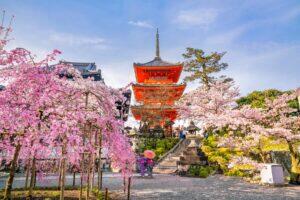Fodor's Expert Review West Hongan-ji Temple
The interior of this enormous World Heritage site has 1,000 tatami mats in its main hall, and as the headquarters for the Jodo Shinshu sect of Buddhism has a similar number of followers. The compound contains many fine examples of 16th-century Momoyama architecture. Among the most renowned of these is a gate on the south side. Elaborately carved in fascinating detail, it is called Higureshi-no-mon (All the Day Long Gate) because one could stand and look at its depictions of mythical and real animals, birds, and flowers for hours.
Founded in 1272, the sect gained great popularity by appealing to the masses in making paradise accessible by reciting a simple incantation. As with all Jodo Shinshu temples, the main altar is the image of Amida Buddha, surrounded by vases of graceful gold-painted lotus and a canopy of hanging gold ornaments, all of which seem to glow in the darkened hall. Some of the Buddhist images belonging to this temple are now housed in the Ryukoku Museum, across... READ MORE
The interior of this enormous World Heritage site has 1,000 tatami mats in its main hall, and as the headquarters for the Jodo Shinshu sect of Buddhism has a similar number of followers. The compound contains many fine examples of 16th-century Momoyama architecture. Among the most renowned of these is a gate on the south side. Elaborately carved in fascinating detail, it is called Higureshi-no-mon (All the Day Long Gate) because one could stand and look at its depictions of mythical and real animals, birds, and flowers for hours.
Founded in 1272, the sect gained great popularity by appealing to the masses in making paradise accessible by reciting a simple incantation. As with all Jodo Shinshu temples, the main altar is the image of Amida Buddha, surrounded by vases of graceful gold-painted lotus and a canopy of hanging gold ornaments, all of which seem to glow in the darkened hall. Some of the Buddhist images belonging to this temple are now housed in the Ryukoku Museum, across the street on the east side of Horikawa. A re-creation of the murals in Chinese cave paintings have been replicated via photographs in the museum.
Several buildings can be entered if permission is granted that takes from a week to a month to obtain (visit website for details). One of them, the Hiunkaku Pavilion, a graceful three-story structure built in 1587, was once the residence of the warlord Toyotomi Hideyoshi and was moved here. The morning service, which takes place daily at 6 am, provides a good opportunity to observe or participate.
READ LESS







